LE Audio CAP Commander
The purpose of this document is to give an overview of the LE Audio CAP Commander sample. The LE Audio CAP Commander sample implements a very simple LE Audio CAP Commander device and it can be used as a framework to develop many different CAP Commander-role applications.
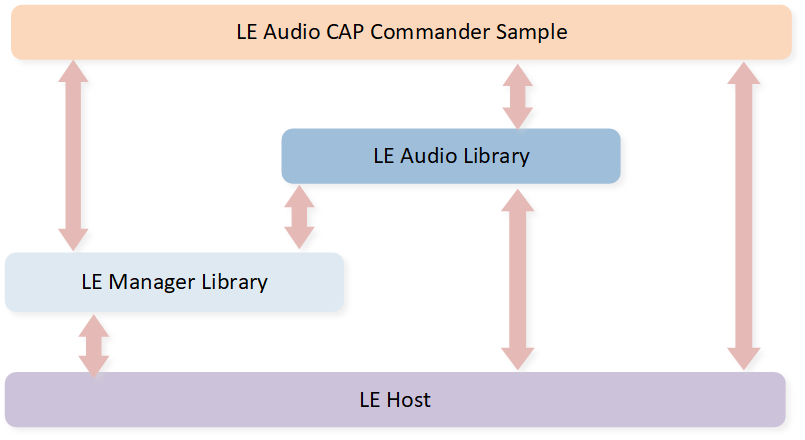
LE Audio CAP Commander Project Architecture
The sample uses LE Host, LE manager, and LE Audio module. The above figure shows the relationships between several modules in the sample.
More information about these modules can be found in the LE Host, LE Manager and LE Audio Manager documentation.
Requirements
The sample supports the following development kits:
Hardware Platforms |
Board Name |
Build Target |
|---|---|---|
RTL87x3E EVB |
|
|
RTL87x3D HDK |
RTL87x3D EVB |
|
Note
To purchase EVB, please visit https://www.realmcu.com/en/Home/Shop.
This sample project can be found under board\evb\lea_cap_commander in SDK folder structure.
Developers can choose the project according to the Board Name and choose the Build Target according to the flash map.
When built for an xxx_4M_xxx build target, the sample is configured to build and run with a 4M flash map.
When built for an xxx_8M_xxx build target, the sample is configured to build and run with an 8M flash map.
When built for an xxx_16M_xxx build target, the sample is configured to build and run with a 16M flash map.
For more requirements, please refer to Quick Start.
Wiring
The sample requires support for a user command interface. For specific wiring instructions, please refer to Data UART Connection in User Command Interface.
Configurations
The configurations for the sample include Configurable Items and Generating System Configuration File.
Configurable Items
The sample's configurable functions are defined in src\sample\lea_samples\lea_cap_commander\app_lea_cap_com_flags.h:
-
LE Link Number
The LE link number is configured by macro definition
APP_MAX_BLE_LINK_NUM./** * @brief Config APP LE link number * */ #define APP_MAX_BLE_LINK_NUM 2
-
GATT Client Service Table Storage
The macro definition
GATTC_TBL_STORAGE_SUPPORTis used to configure the sample to support GATT discovery result storage.0 - Do not store GATT discovery result.
1 - Store GATT discovery result to FTL.
#define GATTC_TBL_STORAGE_SUPPORT 1 -
CAP Role
Define the CAP role that the sample will support.
#define CAP_ROLE CAP_COMMANDER_ROLE -
CAP Role Component
// CAP role component #define BAP_UNICAST_CLIENT 0 #define BAP_UNICAST_SERVER 0 #define BAP_BROADCAST_SOURCE 0 #define BAP_BROADCAST_SINK 0 #define BAP_BROADCAST_ASSISTANT 1 #define BAP_SCAN_DELEGATOR 0 #define VCP_VOLUME_CONTROLLER 1 #define VCP_VOLUME_RENDERER 0 #define MICP_MIC_CONTROLLER 1 #define MICP_MIC_DEVICE 0 #define CCP_CALL_CONTROL_SERVER 0 #define CCP_CALL_CONTROL_CLIENT 0 #define MCP_MEDIA_CONTROL_SERVER 0 #define MCP_MEDIA_CONTROL_CLIENT 0 #define CSIP_SET_COORDINATOR 1 #define CSIP_SET_MEMBER 0
-
Optional LE Audio Profile Role Supported
#define APP_LEA_VOCS_CLIENT_SUPPORT (VCP_VOLUME_CONTROLLER && 1) #define APP_LEA_AICS_CLIENT_SUPPORT ((VCP_VOLUME_CONTROLLER || MICP_MIC_CONTROLLER) && 1)
-
PA Information Print
If the sample wants to print the PA information, the macro definition
APP_PA_PRINT_INFOshall be enabled.#define APP_PA_PRINT_INFO 0
Generating System Configuration File
Developers shall configure the following items through MCUConfig Tool:
Configurable Item |
Value |
|---|---|
LE link number |
≥ |
LE master link number |
≥ |
CCCD count |
64 |
CCCD per link count |
32 |
LE bond device number |
≥ |
Support LE Isochronous |
Enable |
LE CIG number |
2 |
LE CIS number |
4 |
LE BIG number |
2 |
LE BIS number |
4 |
Support LE PA |
Enable |
LE PA number |
2 |
Building and Downloading
Take the project rtl87x3e_lea_cap_commander.uvprojx and target lea_cap_commander_4M_bank0 as an example,
to build and run the sample with Keil development environment. Follow the steps listed below:
Open
rtl87x3e_lea_cap_commander.uvprojx.-
Choose the build target
lea_cap_commander_4M_bank0.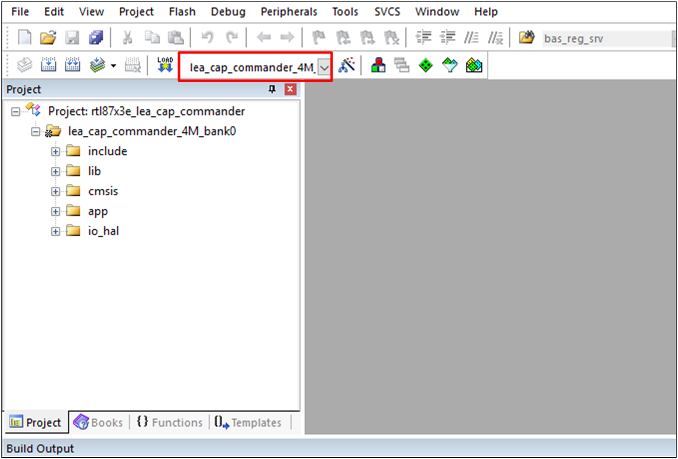
Choose LE Audio CAP Commander Project Build Target
-
Build the target.

Build LE Audio CAP Commander Project
After a successful compilation, the sample bin file
lea_cap_commander_bank0_MP-v0.0.0.0-xxx.binwill be generated in the directorybin\rtl87x3e\flash_4M_dualbank\bank0. Download the sample bin into the EVB board.
Press the reset button on the EVB board and it will start running.
Experimental Verification
After downloading the sample bin to the EVB board, developers can test it either by using another kit that is running the LE Audio CAP Acceptor.
Testing with Another Kit
Prepare two development boards named DUT and Tester respectively, and use Debug Analyzer to get the logs. For more information, please refer to Debug Analyzer.
Preparation Phase
Use MCUConfig Tool to set DUT address to [00:11:22:33:44:80], and then build the LE Audio CAP Commander sample, and download images into DUT. Developers can enter the user command in the Serial Port Assistant Tool in PC. Please refer to How to Use Commands? in User Command Interface.
-
Use MCUConfig Tool to set Tester address to [00:11:22:33:44:85], and then build the LE Audio CAP Acceptor sample, and download images into Tester. Developers can enter the user command in the Serial Port Assistant Tool in PC. Please refer to How to Use Commands? in User Command Interface.
For more information, please refer to the chapter Building and Downloading in LE Audio CAP Acceptor sample.
For details about how to change the Bluetooth Address, please refer to MCUConfig Tool.
Testing Phase
-
Press the reset button on DUT and the developer can enter the user commands in Serial Port Assistant Tool on the PC.
If the DUT successfully boots up and the Serial Port Assistant Tool configuration is successful, the log will be shown as below. The Serial Port Assistant Tool will display the local address. If developers don't see the following log, please check if the software and hardware environment is configured correctly.
>> Command Parse Init () << local bd addr: 0xXX:XX:XX:XX:XX:XX
-
Press the reset button on Tester and the developer can enter the user commands in Serial Port Assistant Tool on the PC.
If the Tester successfully boots up and the Serial Port Assistant Tool configuration is successful, the log will be shown as below. The Serial Port Assistant Tool will display the local address. If developers don't see the following log, please check if the software and hardware environment is configured correctly.
Tester will show the following logs when inputting the reg 0 command.
>> Command Parse Init (le_audio) << reg 0 local bd addr: 0xXX:XX:XX:XX:XX:XX adv start
The test flow is shown as below:
Test Flow Step
DUT User Command
Tester User Command
Description
Log
1
bondclear
reg 0
DUT: Clear all the bond information.
Tester: Register LE Audio profiles, make Bluetooth Host ready, but do not register CSIS.
2
leascan
DUT: Start scan, the advertising report will be filtered by UUID ASCS, CAS, and BASS.
DUT Serial Port Assistant Tool shows:
lea scan start Add RemoteBd[dev_idx]: [Dev_ACC_NO_CSIS]
3
leastopscan
DUT: Stop scan, when the Tester address is shown on the Serial Port Assistant Tool in the scan device list.
DUT Serial Port Assistant Tool shows:
Add RemoteBd[dev_idx]: [Dev_ACC_NO_CSIS]
4
condev [dev_idx]
DUT: Create connection with Tester, the dev_idx needs to be written according to the scan device list log printed before.
DUT Serial Port Assistant Tool shows:
Connected success conn_id 0 Pair success Add Group[0]: group_handle 0xXXXXXXXX, set_mem_size 0
5
gvcsvolume 0 40
DUT: Set the volume_setting to 40 after the log Add Group[0] is shown.
Tester Serial Port Assistant Tool shows:
LE_AUDIO_MSG_VCS_VOLUME_CP_IND: volume_setting 40, mute 0
DUT Serial Port Assistant Tool shows:
VCS_CHAR_VOLUME_STATE: volume_setting 40, mute 0, change_counter 0x00000001
6
gvcsmute 0 1
DUT: If inputting this command when the mute is 0, the mute value of VCS will be set to VCS_MUTED.
Tester Serial Port Assistant Tool shows:
LE_AUDIO_MSG_VCS_VOLUME_CP_IND: volume_setting 40, mute 1, cp_op 6
7
gvcsmute 0 0
DUT: If inputting this command when the mute is 1, the mute value of VCS will be set to VCS_NOT_MUTED.
Tester Serial Port Assistant Tool shows:
LE_AUDIO_MSG_VCS_VOLUME_CP_IND: volume_setting 40, mute 0, cp_op 5
8
gvcscp 0 0
DUT: Send control point VCS_CP_UNMUTE_RELATIVE_VOLUME_DOWN.
Tester: The volume_setting decreases in value.
Tester Serial Port Assistant Tool shows:
LE_AUDIO_MSG_VCS_VOLUME_CP_IND: volume_setting 23, mute 0, cp_op 0
9
gvcscp 0 1
DUT: Send control point VCS_CP_RELATIVE_VOLUME_UP.
Tester: The volume_setting increases in value.
Tester Serial Port Assistant Tool shows:
LE_AUDIO_MSG_VCS_VOLUME_CP_IND: volume_setting 40, mute 0, cp_op 1
10
vcsupdate 0
Tester: The volume_setting value changes to 10, and the change_counter value is increased by 1.
DUT Serial Port Assistant Tool shows:
VCS_CHAR_VOLUME_STATE: volume_setting 10, mute 0, change_counter 0x00000014
11
vcsupdate 2
Tester: The mute value changes to 1 (VCS_MUTED), and the change_counter value is increased by 1.
DUT Serial Port Assistant Tool shows:
VCS_CHAR_VOLUME_STATE: volume_setting 10, mute 1, change_counter 0x00000015
12
vcsupdate 3
Tester: The volume_flags value changes to 0.
DUT Serial Port Assistant Tool shows:
VCS_CHAR_VOLUME_FLAGS: volume_flags 0x00000000
Code Overview
The main purpose of this chapter is to help sample developers familiarize themselves with the development process related to the CAP Commander role. LE Audio CAP Commander sample code overview will be introduced according to the following several parts:
LE Audio CAP Commander sample project overview will be introduced in chapter Source Code Directory.
For CAP Commander-related parameters and Bluetooth Host initialization, please refer to the chapter Initialization.
For CAP Commander-related GAP message handler, please refer to the chapter GAP Message Handler.
For CAP Commander-related callback handler, please refer to the chapter Callback Message Handler.
For CAP Commander-related test flow, please refer to the chapter LE Audio Flow.
Source Code Directory
This section describes the project directory and project structure. Reference files directory is as follows:
Project directory:
board\evb\lea_cap_commander.Project source code directory:
src\sample\lea_samples\lea_cap_commander.
Source files in the sample project are currently categorized into several groups as below:
└── lea_cap_commander_4M_bank0
├── include ROM UUID header files. Developers do not need to modify it.
├── lib The protocol stack and GAP library file. Developers do not need to modify it.
├── gap_utils.lib
├── ROM.lib
├── upperstack_4M.lib
├── hal_utils.lib
├── ble_mgr.lib
├── leaudio.lib
├── sysm.lib
├── cmsis The CMSIS source code. Developers do not need to modify it.
├── APP The sample source code.
├── data_uart.c
├── user_cmd_parse.c
├── bt_ext_ftl.c GATT discovery result storage
├── gattc_tbl_storage.c
├── app_lea_cap_com_main.c Main entry
├── app_lea_cap_com_gap.c LE GAP initialization and message handler
├── app_lea_cap_com_profile.c LE Audio profile initialization
├── app_lea_cap_com_link.c LE link utility
├── app_lea_cap_com_user_cmd.c User Command
├── app_lea_cap_com_scan.c Scan manager
├── app_lea_cap_com_csis.c CSIS message handler
├── app_lea_cap_com_bap.c BAP message handler
├── app_lea_cap_com_cap.c CAP message handler
└── io_hal
Initialization
The main() function is invoked when the board is powered on or the chip boots up, and it performs the following initialization functions:
int main(void)
{
app_msg_init();
board_init();
app_gap_init();
framework_init();
app_lea_profile_init();
pwr_mgr_init();
task_init();
os_sched_start();
return 0;
}
GAP Parameter Initialization
The app_gap_init() function is used to initialize the GAP parameters.
Developers can easily customize the sample by modifying the following parameter values:
void app_gap_init(void)
{
le_gap_init(APP_MAX_BLE_LINK_NUM);
gap_lib_init();
/* Device name and device appearance */
uint8_t device_name[GAP_DEVICE_NAME_LEN] = "CAP Commander";
uint16_t appearance = GAP_GATT_APPEARANCE_UNKNOWN;
le_set_gap_param(GAP_PARAM_DEVICE_NAME, GAP_DEVICE_NAME_LEN, device_name);
le_set_gap_param(GAP_PARAM_APPEARANCE, sizeof(appearance), &appearance);
/* Use LE Advertising Extensions */
uint8_t use_extended = true;
le_set_gap_param(GAP_PARAM_USE_EXTENDED_ADV, sizeof(use_extended), &use_extended);
/* GAP Bond Manager parameters */
uint8_t auth_pair_mode = GAP_PAIRING_MODE_PAIRABLE;
uint16_t auth_flags = GAP_AUTHEN_BIT_BONDING_FLAG | GAP_AUTHEN_BIT_SC_FLAG;
uint8_t auth_io_cap = GAP_IO_CAP_NO_INPUT_NO_OUTPUT;
uint8_t auth_oob = false;
uint8_t auth_use_fix_passkey = false;
uint32_t auth_fix_passkey = 0;
uint8_t auth_sec_req_enable = true;
uint16_t auth_sec_req_flags = GAP_AUTHEN_BIT_BONDING_FLAG | GAP_AUTHEN_BIT_SC_FLAG;
uint8_t irk_auto = true;
gap_set_param(GAP_PARAM_BOND_PAIRING_MODE, sizeof(auth_pair_mode), &auth_pair_mode);
gap_set_param(GAP_PARAM_BOND_AUTHEN_REQUIREMENTS_FLAGS, sizeof(auth_flags), &auth_flags);
gap_set_param(GAP_PARAM_BOND_IO_CAPABILITIES, sizeof(auth_io_cap), &auth_io_cap);
gap_set_param(GAP_PARAM_BOND_OOB_ENABLED, sizeof(auth_oob), &auth_oob);
le_bond_set_param(GAP_PARAM_BOND_FIXED_PASSKEY, sizeof(auth_fix_passkey), &auth_fix_passkey);
le_bond_set_param(GAP_PARAM_BOND_FIXED_PASSKEY_ENABLE, sizeof(auth_use_fix_passkey),
&auth_use_fix_passkey);
le_bond_set_param(GAP_PARAM_BOND_SEC_REQ_ENABLE, sizeof(auth_sec_req_enable), &auth_sec_req_enable);
le_bond_set_param(GAP_PARAM_BOND_SEC_REQ_REQUIREMENT, sizeof(auth_sec_req_flags),
&auth_sec_req_flags);
le_bond_set_param(GAP_PARAM_BOND_GEN_LOCAL_IRK_AUTO, sizeof(uint8_t), &irk_auto);
/* register gap message callback */
le_register_app_cb(app_gap_callback);
/* register gap common message callback */
gap_register_app_cb(app_gap_common_callback);
/* LE manager module initialize*/
app_ble_mgr_lib_init();
}
-
Initialize GAP and set link number.
-
Initialize
gap_utils.lib. -
Configure the device name with the parameter
GAP_PARAM_DEVICE_NAME.Configure the appearance with the parameter
GAP_PARAM_APPEARANCE.Configure the sample to use LE Advertising Extensions with the parameter
GAP_PARAM_USE_EXTENDED_ADV.
-
gap_set_param()andle_bond_set_param()Initialize GAP pairing parameters.
-
le_register_app_cb()andgap_register_app_cb()Register the GAP message callback function
app_gap_callback()and GAP common message callback functionapp_gap_common_callback(), and all GAP callback messages will be handled in these callbacks. -
app_ble_mgr_lib_init()Initialize the LE manager library. More information can be found in the chapter LE Manager Initialization of LE Manager.
void app_ble_mgr_lib_init(void) { BLE_MGR_PARAMS param = {0}; param.ble_scan.enable = true; param.ble_conn.enable = true; param.ble_conn.link_num = APP_MAX_BLE_LINK_NUM; ble_mgr_init(¶m); gap_vendor_le_set_host_feature(0, 1); }
More information on LE GAP initialization and startup flow can be found in the GAP Parameters Initialization chapter of the LE Host.
LE Audio Profile Initialization
The app_lea_profile_init() function is used to initialize the LE Audio profiles parameters.
Developers can easily customize the sample by modifying the following parameter values:
void app_lea_profile_init(void)
{
#if GATTC_TBL_STORAGE_SUPPORT
gattc_tbl_storage_init();
#endif
T_BLE_AUDIO_PARAMS ble_audio_param = {0};
ble_audio_param.evt_queue_handle = app_evt_queue_handle;
ble_audio_param.io_queue_handle = app_io_queue_handle;
ble_audio_param.bt_gatt_client_init = (GATT_CLIENT_DISCOV_MODE_REG_SVC_BIT |
GATT_CLIENT_DISCOV_MODE_CCCD_STORAGE_BIT |
GATT_CLIENT_DISCOV_MODE_USE_EXT_CLIENT);
ble_audio_param.acl_link_num = APP_MAX_BLE_LINK_NUM;
ble_audio_param.io_event_type = IO_MSG_TYPE_LE_AUDIO;
ble_audio_init(&ble_audio_param);
app_lea_com_bap_init();
app_lea_com_cap_init();
}
-
gattc_tbl_storage_init()Initialize GATT client service table storage function.
-
Initialize LE Audio parameters.
-
app_lea_com_bap_init()Initialize LE Audio BAP role.
void app_lea_com_bap_init(void) { T_BAP_ROLE_INFO role_info = {0}; ble_audio_cback_register(app_lea_com_bap_handle_msg); #if BAP_BROADCAST_ASSISTANT role_info.role_mask |= BAP_BROADCAST_ASSISTANT_ROLE; role_info.pa_sync_num = APP_MAX_SYNC_HANDLE_NUM; #endif role_info.init_gap = true; bap_role_init(&role_info); }
-
app_lea_com_cap_init()Initialize LE Audio CAP related parameters.
void app_lea_com_cap_init(void) { T_CAP_INIT_PARAMS cap_init_param = {0}; ble_audio_cback_register(app_lea_com_cap_handle_msg); cap_init_param.cap_role = CAP_ROLE; cap_init_param.cas_client = true; #if CSIP_SET_COORDINATOR app_lea_com_csis_init(&cap_init_param); #endif #if VCP_VOLUME_CONTROLLER cap_init_param.vcp_micp.vcp_vcs_client = true; #endif #if MICP_MIC_CONTROLLER cap_init_param.vcp_micp.micp_mic_controller = true; #endif #if APP_LEA_AICS_CLIENT_SUPPORT cap_init_param.vcp_micp.vcp_aics_client = true; #endif #if APP_LEA_VOCS_CLIENT_SUPPORT cap_init_param.vcp_micp.vcp_vocs_client = true; #endif cap_init(&cap_init_param); }
More information can be found in the LE Audio Manager.
GAP Message Handler
The app_handle_gap_msg() function is invoked whenever a GAP message is received from the GAP.
More information on GAP messages can be found in the Bluetooth LE GAP Message chapter
of the LE Host.
void app_handle_gap_msg(T_IO_MSG *p_gap_msg)
{
T_LE_GAP_MSG gap_msg;
memcpy(&gap_msg, &p_gap_msg->u.param, sizeof(p_gap_msg->u.param));
ble_mgr_handle_gap_msg(p_gap_msg->subtype, &gap_msg);
APP_PRINT_TRACE1("app_handle_gap_msg: subtype %d", p_gap_msg->subtype);
switch (p_gap_msg->subtype)
{
case GAP_MSG_LE_DEV_STATE_CHANGE:
{
app_handle_dev_state_evt(gap_msg.msg_data.gap_dev_state_change.new_state,
gap_msg.msg_data.gap_dev_state_change.cause);
}
break;
case GAP_MSG_LE_CONN_STATE_CHANGE:
{
app_handle_conn_state_evt(gap_msg.msg_data.gap_conn_state_change.conn_id,
(T_GAP_CONN_STATE)gap_msg.msg_data.gap_conn_state_change.new_state,
gap_msg.msg_data.gap_conn_state_change.disc_cause);
}
break;
......
case GAP_MSG_LE_AUTHEN_STATE_CHANGE:
{
app_handle_authen_state_evt(gap_msg.msg_data.gap_authen_state.conn_id,
gap_msg.msg_data.gap_authen_state.new_state,
gap_msg.msg_data.gap_authen_state.status);
}
break;
......
default:
break;
}
ble_audio_handle_gap_msg(p_gap_msg->subtype, gap_msg);
}
-
The CAP Commander sample will call
app_lea_start_discovery()to start the service discovery procedure when receivingGAP_AUTHEN_STATE_COMPLETEwith causeGAP_SUCCESS.void app_handle_authen_state_evt(uint8_t conn_id, uint8_t new_state, uint16_t cause) { APP_PRINT_INFO2("app_handle_authen_state_evt:conn_id %d, cause 0x%x", conn_id, cause); switch (new_state) { ...... case GAP_AUTHEN_STATE_COMPLETE: { T_APP_LE_LINK *p_link; p_link = app_link_find_le_link_by_conn_id(conn_id); if (p_link) { if (cause == GAP_SUCCESS) { data_uart_print("Pair success\r\n"); APP_PRINT_INFO0("app_handle_authen_state_evt: GAP_AUTHEN_STATE_COMPLETE pair success"); p_link->auth_cmpl = true; app_lea_start_discovery(p_link); } else { data_uart_print("Pair failed: cause 0x%x\r\n", cause); APP_PRINT_INFO0("app_handle_authen_state_evt: GAP_AUTHEN_STATE_COMPLETE pair failed"); p_link->auth_cmpl = false; } } } break; default: { APP_PRINT_ERROR1("app_handle_authen_state_evt: unknown new_state %d", new_state); } break; } }
-
LE Audio library handles GAP messages.
Callback Message Handler
When CAP Commander sample handles GAP callback, the ble_mgr_handle_gap_cb() and ble_audio_handle_gap_cb() will be
called to handle the callback message.
If the GATTC_TBL_STORAGE_SUPPORT is enabled, CAP Commander sample will call gattc_tbl_storage_handle_bond_modify() when
receiving GAP_MSG_LE_BOND_MODIFY_INFO. If the bond information of the remote device is deleted, the GATT service table of
the same remote device will be removed together.
T_APP_RESULT app_gap_callback(uint8_t cb_type, void *p_cb_data)
{
T_APP_RESULT result = APP_RESULT_SUCCESS;
T_LE_CB_DATA *p_data = (T_LE_CB_DATA *)p_cb_data;
ble_mgr_handle_gap_cb(cb_type, p_cb_data);
ble_audio_handle_gap_cb(cb_type, p_cb_data);
//APP_PRINT_TRACE1("app_gap_callback: cb_type 0x%x", cb_type);
switch (cb_type)
{
case GAP_MSG_LE_CONN_UPDATE_IND:
APP_PRINT_INFO5("GAP_MSG_LE_CONN_UPDATE_IND: conn_id %d, conn_interval_max 0x%x, conn_interval_min 0x%x, conn_latency 0x%x,supervision_timeout 0x%x",
p_data->p_le_conn_update_ind->conn_id,
p_data->p_le_conn_update_ind->conn_interval_max,
p_data->p_le_conn_update_ind->conn_interval_min,
p_data->p_le_conn_update_ind->conn_latency,
p_data->p_le_conn_update_ind->supervision_timeout);
/* if reject the proposed connection parameter from peer device, use APP_RESULT_REJECT. */
result = APP_RESULT_ACCEPT;
break;
case GAP_MSG_LE_BOND_MODIFY_INFO:
APP_PRINT_INFO1("GAP_MSG_LE_BOND_MODIFY_INFO: type 0x%x",
p_data->p_le_bond_modify_info->type);
#if GATTC_TBL_STORAGE_SUPPORT
gattc_tbl_storage_handle_bond_modify(p_data->p_le_bond_modify_info);
#endif
break;
default:
//APP_PRINT_ERROR1("app_gap_callback: unhandled cb_type 0x%x", cb_type);
break;
}
return result;
}
LE Audio Flow
This chapter describes the LE Audio flows related to the Commander role:
Discovery and Connect Acceptor Role Device without CSIS
Discovery and connect Acceptor role device without CSIS flow is shown below:
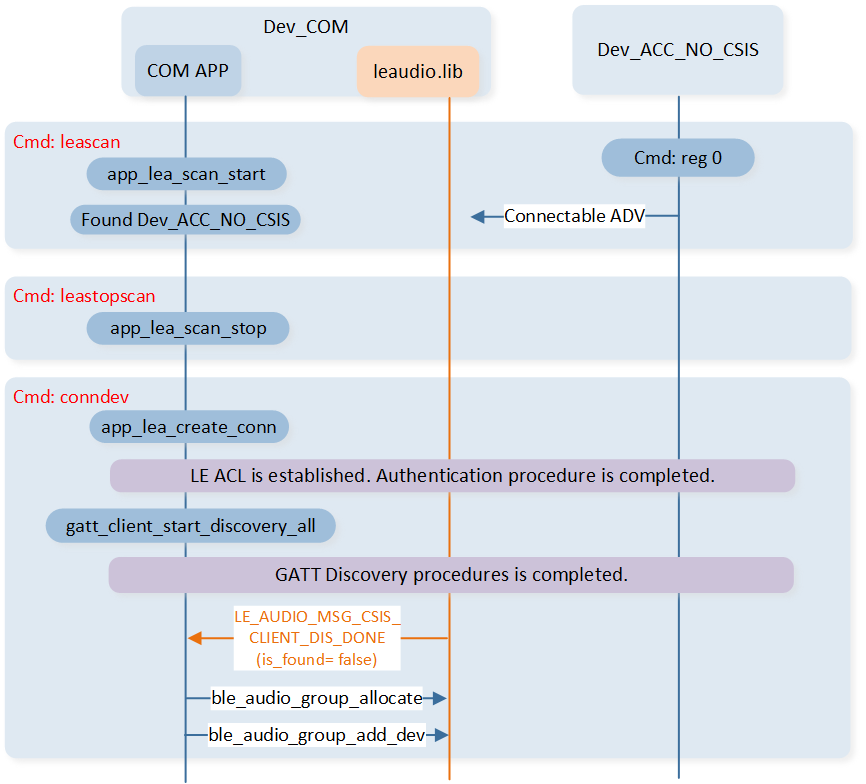
Discovery and Connect Acceptor Role Device without CSIS Procedure
-
LE_AUDIO_MSG_CSIS_CLIENT_DIS_DONELE Audio manager will send this message to inform whether CSIS was found.
Discovery and Connect Acceptor Role Device with CSIS
Discovery and connect Acceptor role device with CSIS flow is shown below:

Discovery and Connect Acceptor Role Device with CSIS Procedure
-
LE_AUDIO_MSG_CSIS_CLIENT_READ_RESULTLE Audio manager will send this message when the CSIS read procedure is completed.
-
LE_AUDIO_MSG_CSIS_CLIENT_SET_MEM_FOUNDWhen the sample calls
set_coordinator_cfg_discover()to enter discover mode. LE Audio manager will send this message when the Set Member is found. -
LE_AUDIO_MSG_CSIS_CLIENT_SEARCH_DONEWhen the timer times out or all the Set members are found, the LE Audio manager will exit discovery mode. Then the LE Audio manager will send this message to inform.
Broadcast Audio Reception Start and Stop Flow
Commander acting in the BAP Broadcast Assistant role uses this procedure to start and stop the reception of broadcast Audio Streams by one Acceptor. The Commander role device establishes the PA sync with the Initiator role device as shown below:
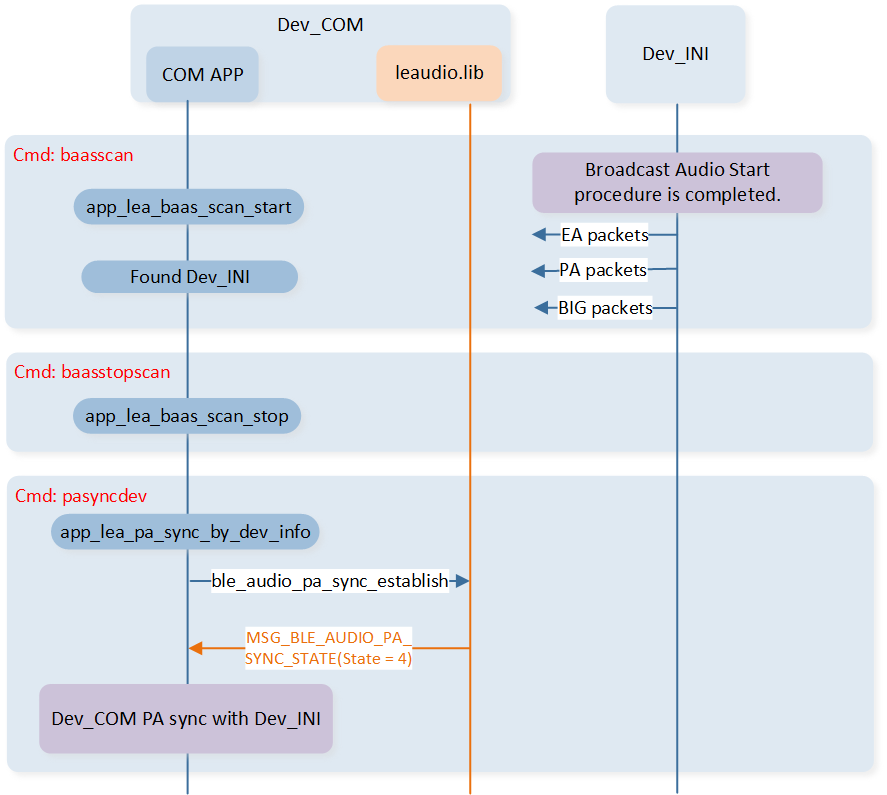
PA Sync Establish Procedure
Broadcast audio reception start and stop are shown as below:
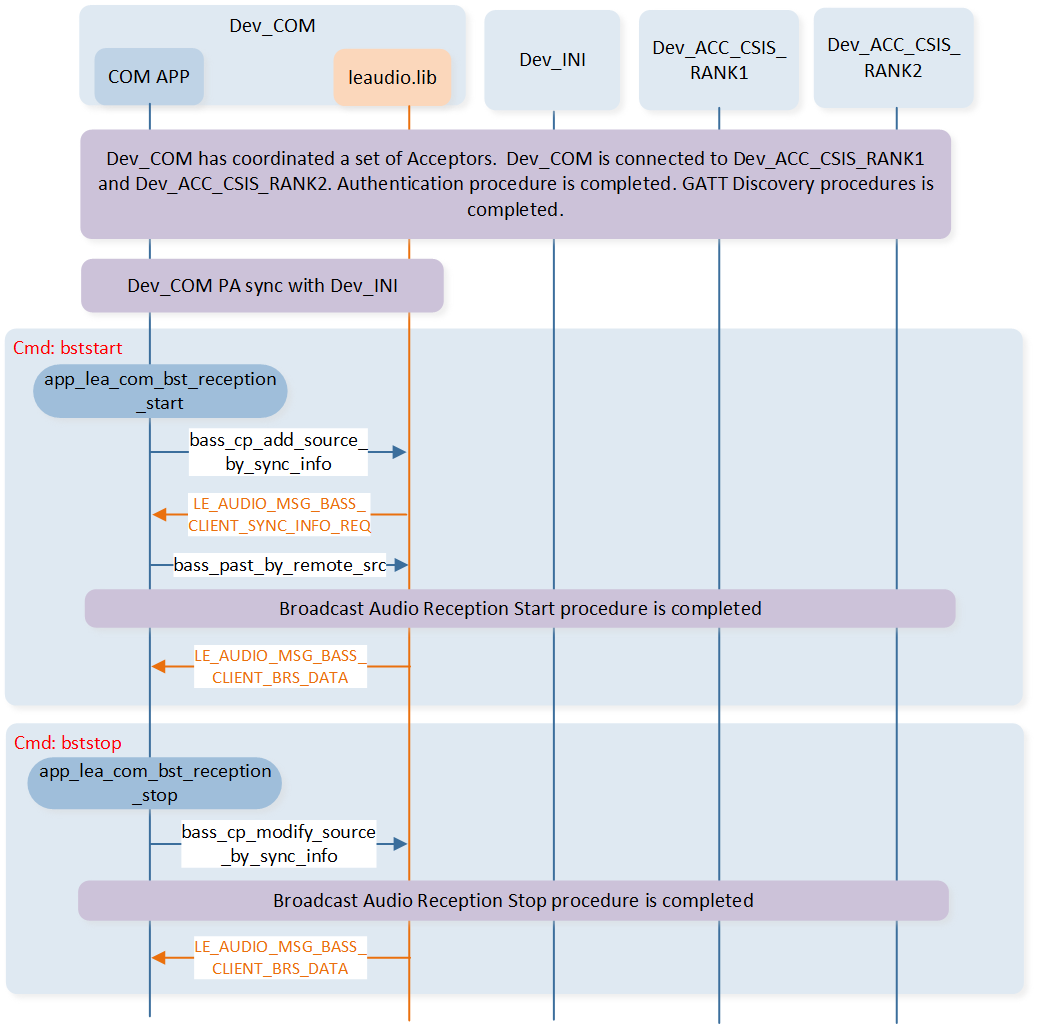
Broadcast Assistant Audio Reception Start and Stop Procedure
-
LE Audio manager will send this message when the PA sync state changes.
-
LE_AUDIO_MSG_BASS_CLIENT_SYNC_INFO_REQLE Audio manager will send this message when the server sends a SyncInfo Request.
-
LE_AUDIO_MSG_BASS_CLIENT_BRS_DATALE Audio manager will send this message when the BASS Broadcast Receive State characteristic value of the remote device changes.
Capture and Rendering Control Procedures
Capture and rendering control procedures are shown as below:
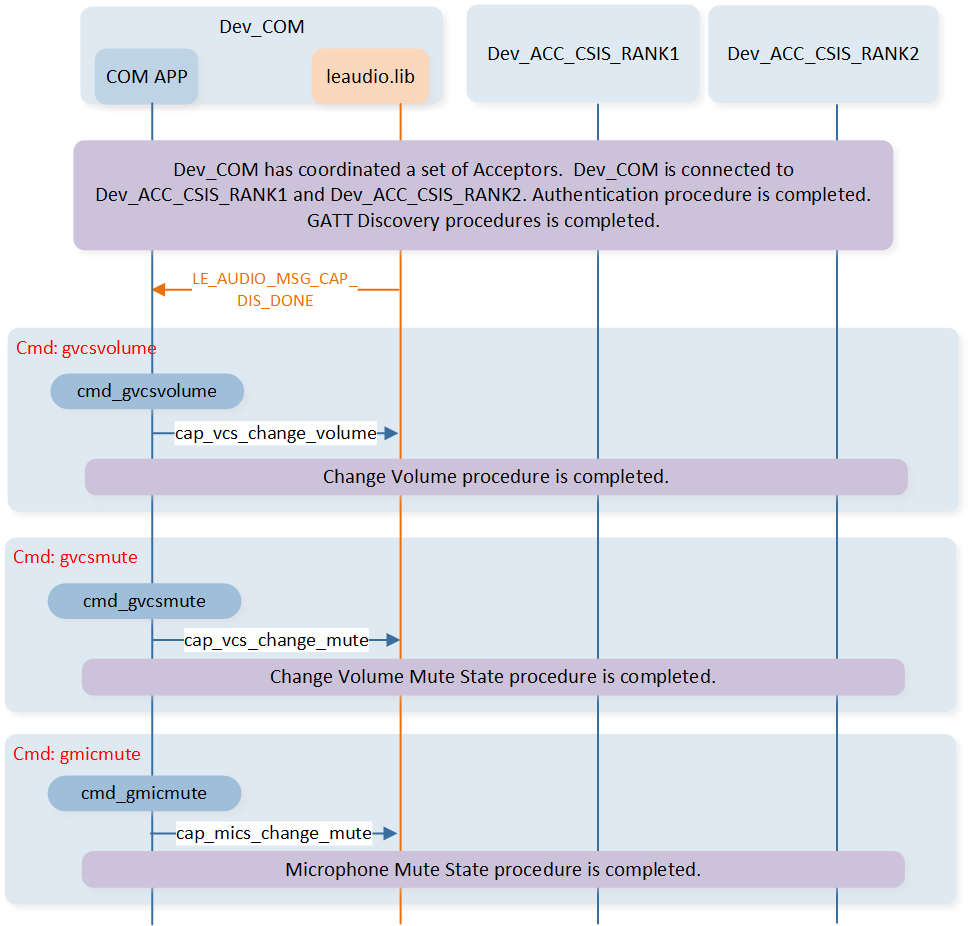
Capture and Rendering Control Procedure
-
LE Audio manager will send this message when the CAP discovery procedure is completed. This message will inform whether CAS, VCS, and MICS are found.
See Also
Please refer to the relevant API Reference: